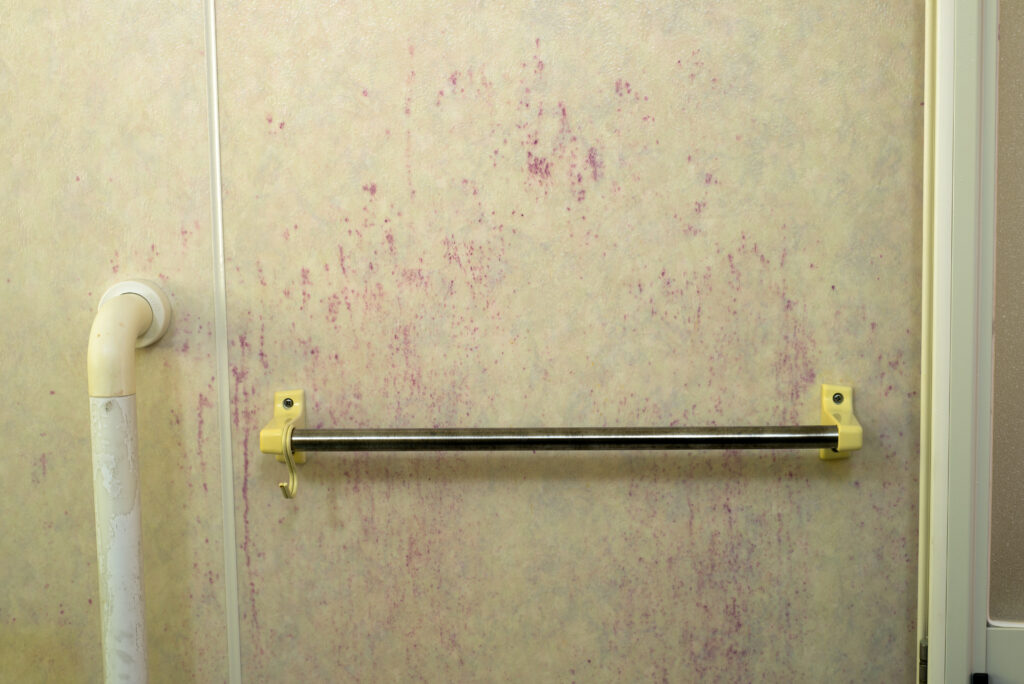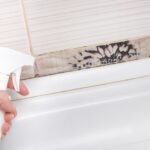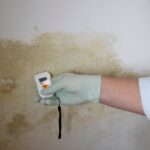Pink Mold – Causes, Risks, and Solutions

Pink mold is a type of bacteria that can grow in damp environments, particularly in places like bathrooms, kitchens, and basements. While it may seem like a harmless, annoying growth, pink mold can pose health risks, especially for people with respiratory issues or weakened immune systems. If you’ve ever noticed a pinkish or reddish tint on your bathroom walls, shower curtains, or around your sink, you may be dealing with this common but often overlooked mold. In this blog, we will explore the causes, risks, and practical solutions to handle pink mold effectively.

What Does Pink Mold Look Like?
Pink mold gets its name from its characteristic color, which ranges from a light, soft pink to a darker, reddish hue. Unlike traditional green or black mold, pink mold has a slightly slimy texture and often appears in streaks or spots. It can be found on various surfaces such as:
- Shower tiles
- Toilets
- Bathroom sinks
- Shower curtains
- Bathtubs
You may also notice pink mold growing on items that are consistently exposed to moisture, such as cleaning sponges, or on rubber seals in dishwashers and refrigerators.
Is Pink Mold Dangerous?
Although pink mold isn’t technically a true mold (it’s often referred to as a “bacterial growth”), it still carries potential health risks. The bacteria found in pink mold can irritate your skin, eyes, and respiratory system. Here’s a breakdown of the risks:
Short-Term Health Risks:
- Respiratory Irritation: Inhaling pink mold spores can lead to coughing, wheezing, and a sore throat. It may also trigger asthma attacks or other pre-existing lung conditions.
- Skin Irritation: Direct contact with pink mold can cause redness, itching, or rashes. If you are prone to skin allergies, you might experience even more severe reactions.
Long-Term Health Risks:
- Infections: Prolonged exposure to bacteria in pink mold can lead to infections, especially in people with weakened immune systems. Those who are already dealing with chronic health conditions are more susceptible.
- Increased Sensitivity: Pink mold can exacerbate allergies or asthma symptoms if left untreated. Over time, this might lead to chronic breathing problems or worsened allergic reactions.
What Causes Pink Mold to Grow?
Pink mold thrives in environments with high humidity and moisture. Its growth is typically the result of several factors:
- Excessive Moisture: Bathrooms, kitchens, and basements are all areas prone to moisture buildup. Steamy showers, leaky pipes, and dripping faucets create the perfect breeding ground for pink mold.
- Poor Ventilation: Insufficient airflow exacerbates moisture accumulation. Without proper ventilation, the moisture doesn’t have a chance to evaporate, allowing bacteria to flourish.
- Organic Materials: Pink mold feeds on organic matter such as soap scum, food particles, and skin oils. In bathrooms, this can include soap residue left on tiles and shower curtains.
- Old, Moisture-Rich Items: Pink mold can also grow on old, damp items like cleaning rags or worn-out shower curtains, which retain moisture and organic matter for long periods.

Where Does Pink Mold Appear?
Pink mold often grows in places where moisture is trapped or persistent. Here are common areas where you might spot it:
- Bathroom: Pink mold loves bathroom surfaces, including sinks, tubs, shower stalls, and tiles.
- Shower Curtains: These are prime breeding grounds because they are regularly exposed to steam and water.
- Toilets: Areas around the toilet seat, especially in corners, are susceptible to pink mold due to regular exposure to moisture and organic waste.
- Kitchen: The sink and countertops, especially those exposed to food scraps and water, are often prone to pink mold growth.
- Washing Machines: Front-load washers that don’t dry completely after use can harbor pink mold in their seals and door areas.
How to Identify Pink Mold in Your Home
It’s not always easy to distinguish between pink mold and other types of mold or bacterial growth. Here are some helpful indicators:
- Color: As the name suggests, pink mold has a pink or reddish hue. However, it can sometimes appear to be light purple or even salmon-colored depending on the surface.
- Texture: Pink mold has a slimy, gelatinous texture. Unlike typical molds, which are often fuzzy, pink mold can feel slick to the touch.
- Location: Check common areas like bathrooms, sinks, and showers for growth in areas that are consistently wet and rarely dry completely.
If you’re unsure whether you’re dealing with pink mold or something else, it’s a good idea to consult with a professional mold inspector for confirmation.
Can You Clean Pink Mold Yourself?
The good news is that you can usually clean pink mold on your own using basic household items. Here’s a step-by-step guide to removing it:
Materials You’ll Need:
- Gloves and Mask: Always wear gloves and a mask to protect your hands and lungs from potential exposure.
- White Vinegar: White vinegar has natural antibacterial properties that can kill pink mold.
- Baking Soda: For scrubbing surfaces and removing stains.
- Hydrogen Peroxide (3%): Another disinfectant that works well on mold.
- Scrub Brush or Sponge: A stiff brush works well for scrubbing hard-to-reach areas.
Step-by-Step Guide:
- Spray the Area: Apply white vinegar directly to the affected areas and let it sit for at least 10 minutes. The vinegar will kill the bacteria and break down the mold.
- Scrub the Surface: After letting the vinegar sit, scrub the moldy areas with a brush or sponge. Be sure to focus on any grooves or corners where the mold may be embedded.
- Rinse and Repeat: Rinse the area with warm water and repeat the process if needed. For stubborn spots, you can use hydrogen peroxide or a baking soda paste to scrub away the remaining mold.
- Dry the Area: Once you’ve cleaned the surface, dry it completely to prevent the mold from coming back.
If the mold persists or if it’s grown on porous materials like drywall or insulation, you may need professional help to prevent it from spreading further.

Preventing Pink Mold: Key Tips
To prevent pink mold from coming back, take these preventative measures:
- Keep the Area Dry: After using the bathroom, open the windows, use a fan, or install an exhaust fan to reduce moisture buildup. The less moisture in the air, the less chance pink mold has to grow.
- Regularly Clean: Clean your bathroom and kitchen surfaces regularly to remove soap scum, food scraps, and oils that pink mold feeds on.
- Replace Worn Items: If you have old or worn shower curtains, towels, or sponges, replace them as they can harbor mold and bacteria.
- Fix Leaks: Any leaking pipes or faucets should be repaired immediately to prevent water from collecting in hidden areas.
- Use Anti-Mold Products: Commercial anti-mold sprays and cleaners are available that help prevent mold and bacteria growth.
Frequently Asked Questions About Pink Mold
How Can I Tell If I Have Pink Mold?
Pink mold typically appears as slimy, pink, or reddish growth on damp surfaces, such as shower tiles, bathroom sinks, and toilet seats. It often forms in areas with excess moisture.
Does Pink Mold Smell?
Yes, pink mold can produce a musty or foul odor, especially if it’s been present for a long time. The smell comes from the bacteria feeding on organic materials like soap scum and oils.
Can Pink Mold Be Harmful to My Health?
Yes, prolonged exposure to pink mold can cause respiratory issues, skin irritation, and infections. People with asthma, allergies, or weakened immune systems are more susceptible to health problems caused by pink mold.
Can I Use Bleach to Clean Pink Mold?
While bleach can kill pink mold, it is not the most effective option as it may not completely eliminate the mold. It can also damage surfaces over time. White vinegar or hydrogen peroxide are better alternatives for cleaning pink mold.
How Can I Prevent Pink Mold from Coming Back?
To prevent pink mold, keep areas dry by improving ventilation, regularly clean surfaces, fix any leaks, replace old or damp materials, and use anti-mold sprays or cleaning solutions.
What Causes Pink Mold to Grow?
Pink mold thrives in areas with excess moisture and poor ventilation. It feeds on organic matter like soap scum, food particles, and skin oils. Bathrooms, kitchens, and basements are common breeding grounds.
How Do I Remove Pink Mold from My Bathroom?
To remove pink mold, spray white vinegar on the affected areas, let it sit for about 10 minutes, scrub the surface with a brush, rinse with warm water, and dry the area completely. You can also use hydrogen peroxide or baking soda for tougher spots.
Can Pink Mold Grow in a Washing Machine?
Yes, pink mold can grow in the rubber seals of front-loading washing machines, especially if the machine is not dried properly after each use. Clean the seals with vinegar or a specialized washing machine cleaner to prevent mold buildup.
What Should I Do If the Mold Is on Porous Surfaces?
If pink mold has grown on porous materials like drywall or insulation, cleaning may not be enough. You may need to replace the affected materials to prevent the mold from spreading further.
Is Pink Mold the Same as Black Mold?
No, pink mold is not the same as black mold. While both are types of microbial growth, black mold (Stachybotrys chartarum) is more dangerous to health and has different characteristics. Bacteria cause pink mold, while black mold is a type of fungus.
Keep Your Home Safe from Pink Mold
While pink mold may seem harmless, it can lead to serious health problems if left untreated. Understanding the causes, risks, and cleaning solutions for pink mold can protect your home and family from its harmful effects. Remember to keep areas dry, clean regularly, and address any moisture issues to prevent mold growth in the first place.
If you notice persistent pink mold growth or if it’s located in hard-to-reach areas, don’t hesitate to call in a professional to assess and treat the issue properly. With the right steps, you can maintain a clean, healthy environment free from the dangers of pink mold.










